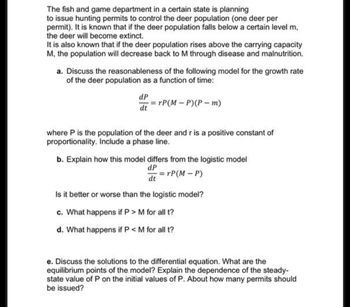
Advanced Engineering Mathematics
10th Edition
ISBN: 9780470458365
Author: Erwin Kreyszig
Publisher: Wiley, John & Sons, Incorporated
expand_more
expand_more
format_list_bulleted
Question

Transcribed Image Text:The fish and game department in a certain state is planning
to issue hunting permits to control the deer population (one deer per
permit). It is known that if the deer population falls below a certain level m,
the deer will become extinct.
It is also known that if the deer population rises above the carrying capacity
M, the population will decrease back to M through disease and malnutrition.
a. Discuss the reasonableness of the following model for the growth rate
of the deer population as a function of time:
dP
=
=rP(M-P)(Pm)
dt
where P is the population of the deer and r is a positive constant of
proportionality. Include a phase line.
b. Explain how this model differs from the logistic model
dP
=rP(M-P)
dt
Is it better or worse than the logistic model?
c. What happens if P > M for all t?
d. What happens if P < M for all t?
e. Discuss the solutions to the differential equation. What are the
equilibrium points of the model? Explain the dependence of the steady-
state value of P on the initial values of P. About how many permits should
be issued?
Expert Solution
This question has been solved!
Explore an expertly crafted, step-by-step solution for a thorough understanding of key concepts.
This is a popular solution
Trending nowThis is a popular solution!
Step by stepSolved in 5 steps

Knowledge Booster
Similar questions
- Given that a zone has 275 household with car and 275 household without car and the average trip generation rates for each group is respectively 5.0 and 2.5 trips per day. Assuming that in the future, all household will have a car, find the growth factor and future trips from that zone, assuming that the population and income remains constant.arrow_forwardDetermine whether the following scenarios are linear or exponential. As summer approaches, I noticed that for every increase in 5 degrees, the number of people I see at the pool increases by about 3. The amount of Francium,a radioactive element, decays by about 3.1% every minute. The number of flu cases increases by about 1.6% per month during flu season. Based on Mrs. Olivet's Test 4 results, students tended to score about 4 more points on their test for every hour they studied. The percentage of the population that has been vaccinated for COVID-19 increased by about 0.25 percentage points every day in January. The population of bugs in Monica's walls decreased by 80% every week while the exterminator was treating her home. During a rainstorm the reading from the rain gauge increased by a quarter inch every hour. Selene didn't want her parents to notice she was stealing candy from the jar, so every day she only ate 1/8 of what was left. While writing an essay, Carson writes 7…arrow_forwardThis exercise uses the population growth model. It is observed that a certain bacteria culture has a relative growth rate of 11% per hour, but in the presence of an antibiotic the relative growth rate is reduced to 5% per hour. The initial number of bacteria in the culture is 24. Find the projected population after 24 hours for the following conditions. (Round your answers to the nearest whole number.) (a) No antibiotic is present, so the relative growth rate is 11%.bacteria (b) An antibiotic is present in the culture, so the relative growth rate is reduced to 5%.bacteriaarrow_forward
arrow_back_ios
arrow_forward_ios
Recommended textbooks for you
 Advanced Engineering MathematicsAdvanced MathISBN:9780470458365Author:Erwin KreyszigPublisher:Wiley, John & Sons, Incorporated
Advanced Engineering MathematicsAdvanced MathISBN:9780470458365Author:Erwin KreyszigPublisher:Wiley, John & Sons, Incorporated Numerical Methods for EngineersAdvanced MathISBN:9780073397924Author:Steven C. Chapra Dr., Raymond P. CanalePublisher:McGraw-Hill Education
Numerical Methods for EngineersAdvanced MathISBN:9780073397924Author:Steven C. Chapra Dr., Raymond P. CanalePublisher:McGraw-Hill Education Introductory Mathematics for Engineering Applicat...Advanced MathISBN:9781118141809Author:Nathan KlingbeilPublisher:WILEY
Introductory Mathematics for Engineering Applicat...Advanced MathISBN:9781118141809Author:Nathan KlingbeilPublisher:WILEY Mathematics For Machine TechnologyAdvanced MathISBN:9781337798310Author:Peterson, John.Publisher:Cengage Learning,
Mathematics For Machine TechnologyAdvanced MathISBN:9781337798310Author:Peterson, John.Publisher:Cengage Learning,


Advanced Engineering Mathematics
Advanced Math
ISBN:9780470458365
Author:Erwin Kreyszig
Publisher:Wiley, John & Sons, Incorporated

Numerical Methods for Engineers
Advanced Math
ISBN:9780073397924
Author:Steven C. Chapra Dr., Raymond P. Canale
Publisher:McGraw-Hill Education

Introductory Mathematics for Engineering Applicat...
Advanced Math
ISBN:9781118141809
Author:Nathan Klingbeil
Publisher:WILEY

Mathematics For Machine Technology
Advanced Math
ISBN:9781337798310
Author:Peterson, John.
Publisher:Cengage Learning,

